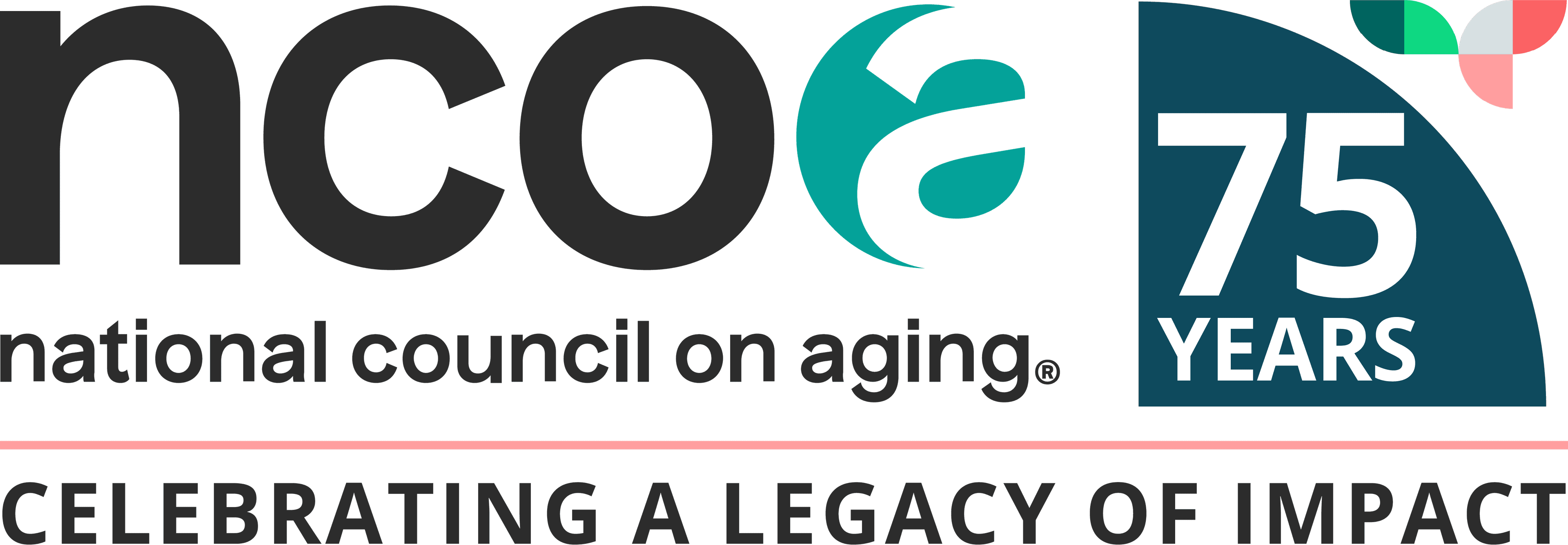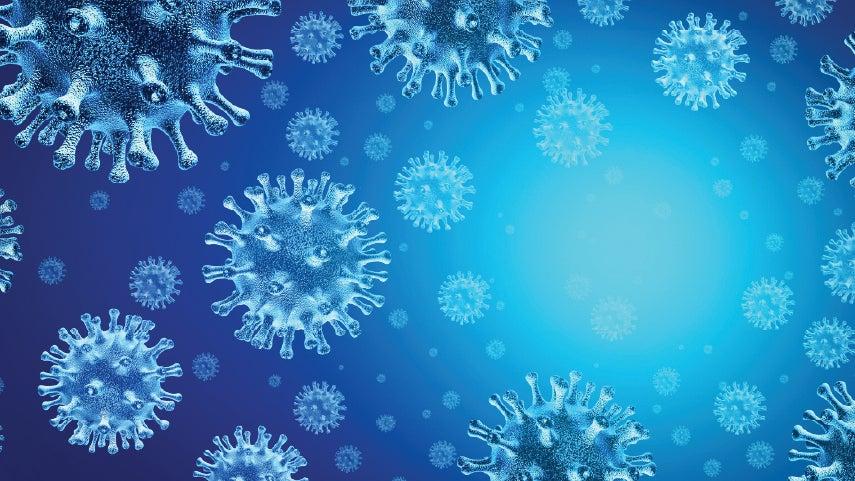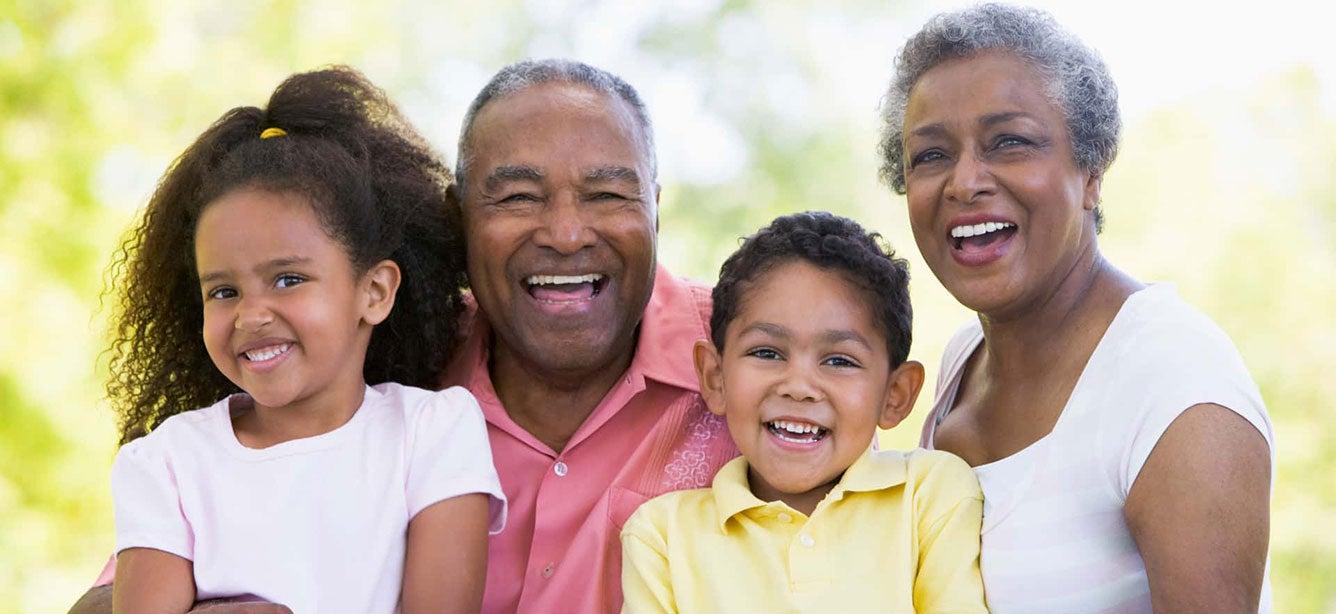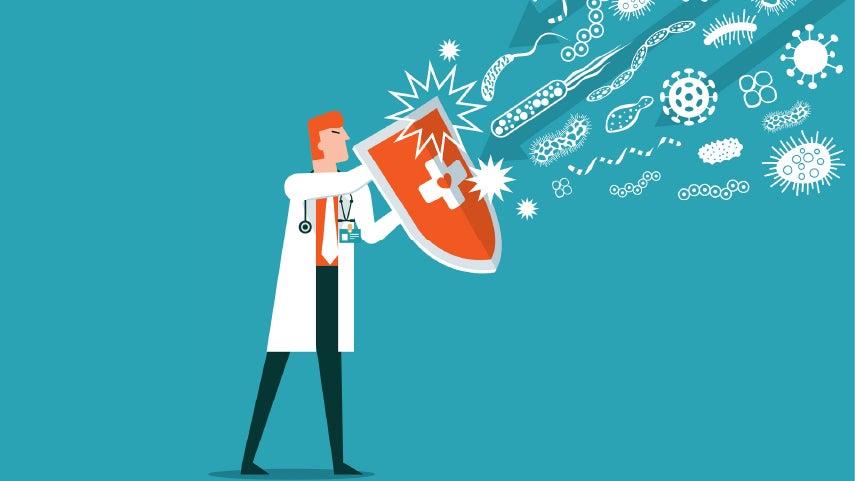
Related Topics
Do you remember the rare outbreak of monkeypox that spurred a public health emergency in the U.S. in 2022? If so, you may also recall hearing rumors that the monkeypox cases being reported were actually cases of shingles.
While shingles and monkeypox are both viral illnesses—and both may involve skin rashes—they are quite different in terms of symptoms, transmission, and prevention. Read on to learn more about each of these conditions and the key distinctions between them.
What is shingles?
Known officially as herpes zoster, shingles is a viral infection caused by the varicella-zoster virus. That’s right—this is the same virus that causes chickenpox. If you had chickenpox as a child (most of us born before 1980 have), the varicella-zoster virus stays “asleep” deep within your nerve tissues. It can then reactivate years later due to age-related changes in your immune system or a health condition that makes your body less able to fight off infections. The result is an episode of shingles that lasts anywhere from three to five weeks.
What are the symptoms of shingles?
One common and notorious symptom of shingles is a painful, blistery rash that erupts on one side of the torso (or in some cases, the neck or face) and crusts over within a few weeks. Before the rash appears, early signs of shingles include a tingling, itching, or burning sensation in the affected area.
Other symptoms of shingles may include:
- Fever/chills
- Headache
- Fatigue
- Upset stomach
After a shingles rash clears, some people are left with long-lasting nerve pain in the same area. This is called postherpetic neuralgia (PHN), which is the most common complication after shingles. Pain from PHN can feel like burning, stabbing, throbbing, or heightened sensitivity—even from light touch or clothing.
What is at high risk of getting shingles?
Shingles is more common in adults age 50 and older, since our immune system works less efficiently as we age. Other risk factors that can trigger an episode of shingles include chronic or extreme stress, certain medications, and medical conditions that compromise the immune system.
Laarni San Juan was 53 when she developed what she thought was a pimple on her face. It turned out to be the early signs of a shingles rash. She thought she'd be back to normal within a few days or weeks—but nine months later, her face was still irritated and red.
More than a year after her shingles outbreak, San Juan has scarring and a left eye that droops slightly. "To think this all could have been prevented by the shingles vaccine—which is recommended by the CDC for people 50 and over—infuriates me," she told Healthy Women. "I never thought I’d be an advocate for a vaccine, but now I find myself spreading awareness about shingles at every opportunity I get, and am also part of a study on shingles."
Is shingles contagious?
Shingles itself is not contagious. However, the varicella-zoster virus can spread to someone who has never had chickenpox, causing them to develop chickenpox rather than shingles. The main way the shingles virus is spread is through direct contact with the fluid from the rash blisters. It can also be transmitted when someone breathes in virus particles from the blisters of a person with an active case of shingles.
How do you avoid getting shingles?
Getting the shingles vaccine (Shingrix) is the best, most effective way to reduce your risk of developing shingles and its complications. For healthy adults age 50 and older (even those who have already had shingles), the Centers for Disease Control and Prevention (CDC) recommends two doses of Shingrix separated by two to six months. According to CDC research, Shingrix was 97% effective in preventing shingles in adults age 50 to 69 with healthy immune systems. In people age 70 and older, the vaccine was 91% effective.1
“As an infectious disease physician, nothing excites me more than to have a vaccine that could prevent something I know could have some consequences and could be very painful,” Sabrina Assoumou, MD, MPH, an infectious disease doctor at Boston Medical Center, told SELF.
Scientists recently discovered another compelling reason to get your shingles shot—it may lower your dementia risk. A 2024 UK study published in the journal Nature Medicine found that older Americans who received Shingrix had a 17% reduced likelihood of developing dementia.2 Dementia is an umbrella term for a set of debilitating cognitive symptoms affecting more than 55 million people around the world. This discovery suggests the shingles vaccine components could potentially hold the key to more effective dementia treatments and prevention.
What’s more, getting vaccinated against shingles may be good for your heart. In a recent study, adults who received the two-dose shingles vaccine had a reduced risk of stroke and heart attack compared to those who did not get the vaccine. This risk reduction was about 18% in adults age 18-49 and 16% in adults age 50 and older.3
What is monkeypox? And is it similar to smallpox?
Monkeypox (mpox) is a rare disease commonly found in Central and West Africa, where it’s endemic (occurs regularly). This disease is caused by the monkeypox virus, which belongs to the same family of viruses as smallpox. Monkeypox has symptoms similar to smallpox, but those symptoms are less severe—and the fatality rate for monkeypox is much lower.
While monkeypox was initially discovered in monkeys, recent outbreaks of the disease have shown us it can be spread from animals to humans. There are two types of mpox: Clade I, which has historically caused higher rates of severe disease, and Clade II. Clade II is a highly survivable (99.9%) type of monkeypox that was responsible for the 2022 global outbreak.
What are the symptoms of monkeypox?
People with monkeypox often start off having flu-like symptoms that include:
- Fever and chills
- Fatigue
- Headache
- Muscle aches
- Swollen lymph nodes
- Respiratory symptoms
Symptoms may then progress to a skin rash that appears as flat red spots on the face, hands, feet, or genitals. These spots evolve into fluid-filled blisters, which eventually scab over, similar to shingles rash blisters.
How is monkeypox spread?
Monkeypox (both types) can be spread from the time symptoms begin until the rash is fully healed. It spreads mainly through:
- Close contact with an infected person’s rash, scabs, or bodily fluids (including through sexual contact)
- Touching contaminated objects, such as clothing or bed linens
- Direct contact with infected animals (in rare cases)
How can monkeypox be prevented?
The smallpox vaccine (JYNNEOS) is not recommended for the general public. However, it is recommended for people at higher risk for monkeypox, such as health care/emergency response professionals or people exposed to confirmed cases. JYNNEOS can be given before potential exposure or after known exposure to the disease.
Other steps to prevent monkeypox include avoiding close contact with infected people, practicing safe sex, and good hygiene habits.
5 key differences between shingles and monkeypox
Below is a quick rundown of the differences between these two illnesses:
| Differences | Shingles | Monkeypox |
| Cause | Reactivation of the varicella-zoster virus, which remains dormant in people who’ve had chickenpox | Caused by the monkeypox virus, unrelated to chickenpox or shingles |
| Rash | Localized rash, typically on one side of the torso, with a burning, tingling, or painful sensation | Rash (often itchy or painful) that starts on the face, hands, feet, or genitals and spreads, along with flu-like symptoms such as fever and fatigue |
| Transmission | Not directly contagious, but the varicella-zoster virus can spread to someone who has never had chickenpox, causing them to develop chickenpox instead shingles | Spread through close contact with an infected person or a contaminated object or surface |
| Those at risk | Primarily affects older adults (age 50+) or people with compromised immune systems | Can affect anyone of any age, but outbreaks often involve settings where people are in close contact |
| Prevention | Prevented with the shingles vaccine (Shingrix) | Prevented with the smallpox vaccine (only advised for certain high-risk people) and by avoiding close contact with people who are infected |
| What to Do and Who to Contact |
|
|
Preventing shingles should be a priority for older adults
“It’s not always easy to tell shingles and monkeypox apart,” said Dorothea Vafiadis, Senior Director of NCOA's Center for Healthy Aging. “A red, bumpy, and often painful skin rash can happen with both conditions, as well as flu-like symptoms. But the fact is these are two very distinct illnesses that are prevented and treated in different ways.”
If you’re 50 or older, preventing shingles should be at the top of your priority list—since the benefits of the vaccine far outweigh the minimal risks. Plus, unlike an annual flu or COVID vaccine, a two-dose Shingrix shot offers solid protection that can last ten or more years.
Shingrix is widely available in doctor's offices and pharmacies and covered by Medicare Part D and Medicaid as well as most private health insurance plans. To find a shingles vaccine provider near you and schedule an appointment today, use this shingles vaccine locator tool.
Sources
1. Centers for Disease Control and Prevention (CDC). Shingles Vaccination. Found on the internet at https://www.cdc.gov/shingles/vaccines/index.html
2. Maxime Taquet, et al. The recombinant shingles vaccine is associated with lower risk of dementia. Nature Medicine. July 25, 2024. Found on the internet at https://www.nature.com/articles/s41591-024-03201-5
3. University of Minnesota CIDRAP. Shingles vaccine linked to lower heart attack, stroke risk. August 28, 2025. Found on the internet at https://www.cidrap.umn.edu/misc-emerging-topics/shingles-vaccine-linked-lower-heart-attack-stroke-risk





